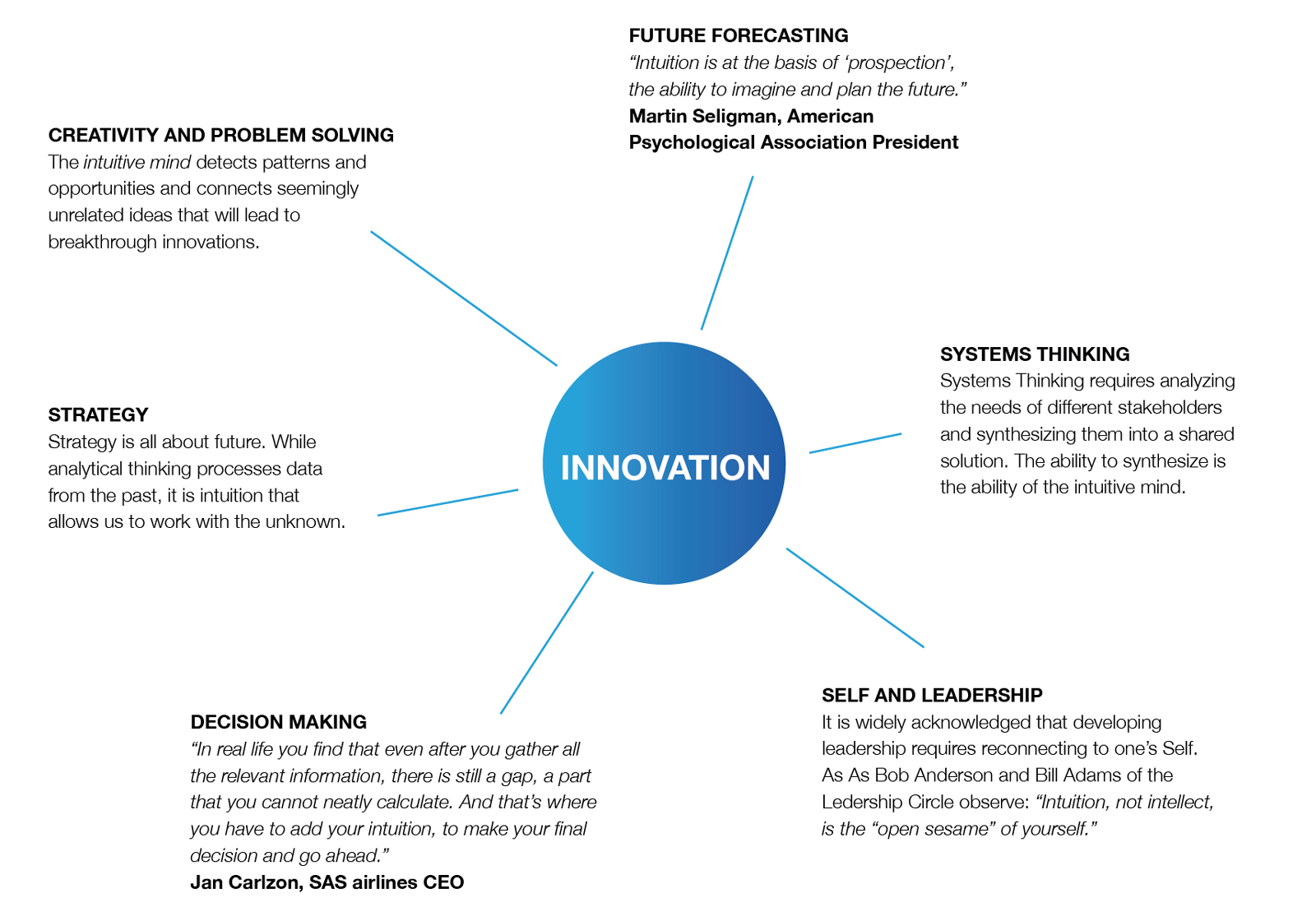We have entered into times of great uncertainty and unparalleled change.
Many leaders have never before come to face today’s great challenges.
In this context, analytical thinking is still necessary but no longer sufficient.
Analytical thinking is in fact the perfect way to manage the status quo in times of stability, when the future is based on the linear evolution of the past. But in times of profound change, it is intuitive thinking that helps us foresee the future.
Two minds in one
Our cognitive system is divided into two minds: the intuitive and the analytical. 1 “The two systems are not separate mechanisms”, explains Lauri Järvilehto 2 of Aalto University in Helsinki, “but rather interact constantly with one another. (The Intuitive Mind) generates both inputs and explicit processes for (the analytical mind) to reflect on and compute with…”. The two minds thus work in synergy but have different functions: the intuitive mind generates the ideas which the analytical mind will reflect on and develop later. The difference is that the analytical mind can work only on existing information, while the intuitive mind allows us to imagine what doesn’t yet exist. They are like a sort of Ianus bifrons, the ancient god with two faces – one looking to the past, the other to the future – the analytical mind looks to the past, while the intuitive mind looks to the future.


Intuition, as argued by former American Psychological Association President Martin Seligman, is at the basis of “prospection”, the ability of imagining and planning the future 3. Seligman defines prospection as “our 21st-Century superpower” 4. Prospective thinking and intuition are the foundations of all future-oriented disciplines, like innovation, creative problem solving, decision making, creativity, and strategic planning.

Innovation
Cognitive psychologist Gary Klein has studied 120 real cases of innovation, discovery, and invention 5. In his analysis he found that people had not necessarily been involved in a particular challenge, nor had conducted a deliberate analysis, nor had time for incubation. However, in all of Klein’s examples there was an unexpected “flash of illumination”, when a new idea or a solution would suddenly become evident. When everybody has the same information, it’s intuition that allows us to take a leap into the unknown.
Decision Making
Economics Nobel prize winner Herbert Simon stated that good management does “not have the luxury of choosing between ‘analytic’ and ‘intuitive’ approaches to problems”. Good management—indeed the ‘art’ of management—involves an ‘intimate combination’ of intuition and analysis 6. As SAS airlines CEO Jan Carlson put it 7 “In real life you find that even after you gather all the relevant information, there is still a gap, a part that you cannot neatly calculate. And that’s where you have to add your intuition, to make your final decision and go ahead.”
Creativity
Science has long proved that invention is born out of intuition. But, it doesn’t take a scientist to understand that of the two minds – the intuitive and the analytical – it’s the intuitive that is at the heart of creative thinking. As the great mathematician Henry Poincaré already pointed out in the last century: “It’s through intuition that we invent, and through reasoning that we prove.”
Forecasting and Strategic Foresight
Strategic foresight can be traced back to the RAND Corporation, a think tank that the US Air Force set up after World War II. At the time, nuclear weapons had fundamentally changed the nature of warfare. Because no one had ever fought a nuclear war before, no one knew how best to fight (or avoid) one. Strategic foresight was born out of the need to face a situation of uncertainty. Uncertainty is marked by novelty, which, by definition, lacks antecedents.
Economist Frank Knight famously argued that uncertainty is best understood when faced with risk 8. In situations of risk we can calculate the probability of a particular outcome, because we have been confronted with many similar situations before (think, for example, of insurance companies that calculate their premiums based on past data). But in situations of uncertainty we can only guess what might happen, because we lack experience to gauge the most likely outcome. The key in those situations, Knight felt, was ‘judgment’, or ‘intuition’.
Creative problem solving
‘Creative Problem Solving’ can be defined as “the process to solve problems which presupposes the invention of an unprecedented solution when the method of attainment is not clear in advance”. In practice, this includes 90% of the problems we tackle daily in the workplace. As in all situations where one has to explore new ground and lacks previous experience, intuition plays a crucial role.
System Thinking
Systemic problems entail composing the interests of many stakeholders into a shared solution. This thought process requires that our two minds work jointly: the analytical mind to gather data and the intuitive mind to boil them down to a solution. This is why Peter Senge, in “The Fifth Discipline”, argues that, “Systems thinking may hold the key to integrating reason and intuition” 9.
Strategy
Intuition is the salt of strategy. It’s about being able to feel the Zeitgeit (spirit of the times) and translating company know-how into actions that fit the spirit of the times. As Michael Porter, the father of strategy, says “Strategic Positionings are often non obvious, and finding them requires creativity and insight.” 10
Accordingly, six CEOs out of ten indicated that gut feelings are highly influential in guiding their business strategies (62%), while only 44% indicated that internal metrics and financial information (44%), or competitor analyses (41%) are highly influential (Business Wire, 2006).
Intuition is so crucial in management, that Herbert Simon in 1978 and Daniel Kahneman in 2002 were awarded the Nobel Memorial prize for their research in intuition applied to management. So, now, this begs the following question: if intuition is so crucial, why is it not taught at business schools? Intuition is the proverbial elephant in the room: everybody practices it, but everybody pretends to ignore it. There are two reasons for intuition not having been widely taught so far.
The first is that many managers have a background in applied sciences. Even if they don’t, chances are, they have an MBA—a degree that originated in the early twentieth century, when Frederick Winslow Taylor was introducing “scientific management.” 11 In this kind of context, intuition appears to be simply as non-scientific. This is also because, for a long time, intuition has been lacking a solid scientific theory to back it up. Today, however, things have changed. Starting from the 70s and 80s, early versions of computerized axial tomography (CAT) scans and magnetic resonance imaging (MRI) allowed us to see, just like in a video, what actually happens in the brain while the mind is working. This way, scientists not only have discovered that intuitive thinking does actually exist, but that it is central to the thinking process. Nowadays intuition is supported by a solid scientific framework.
The second reason that intuition is not being taught at business schools, is that, up to now, intuition training has been complicated and ineffective. The good news is that today Sensing can provide a really effective method to help managers develop intuition and apply it to the disciplines of innovation.
Sensing is the first method for developing intuition and applying it to the disciplines of innovation, as creative problem solving, decision making or strategy. The goal is to help organizations develop the mindset and tools for innovation. In order to do this Sensing acts in three steps.
Step 1. Intuition
First people learn how to use intuition to go to the very heart of the problem. Sensing is based on the assumption that intuitions emerge in the form of feelings. If feelings are the channel along which intuitions flow, by moving up the channel of feelings we can access the information of the intuitive mind directly. When faced with a problem, simply ask yourself “What do I ‘sense’ with respect to this problem?” and Bam! You’ll get to the very heart of it.
Step 2. Creative problem solving
Once people learn how to use feelings to extract information from the intuitive mind, they’ll know how to apply intuition to problem solving. Being able to start from our ability to go to the very heart of the issue represents an invaluble advantage in problem solving. The second advantage is simplicity. Professional problem solvers do not use complex methods, but a combination of analysis and intuition. When people know how to use intuition and understand the logic behind the creative process, problem solving becomes easy and intuitive. In this case, the ability to solve problems will became part of people’s routines and creativity will innervate organizations.
Step 3. Innovation
Once people learn how to use intuition and apply it problem solving, Sensing will allow them to introduce this skill to the disciplines of innovation, such as strategy, decision making, or systems thinking. This ability to apply intuition to strategy comes from the fact that Sensing was born in the context of strategic consulting. In 2003, I launched a method called Perceptioning®, a system that applied intuition to branding. I then discovered a way of coming up with intuitions in problem solving at will. Later, I trained my staff to use this skill, enabling them to achieve great results in problem solving. This experience led me to take my work beyond the confines of my firm. So, I am now a strategy consultant and a pioneer in intuition applied to business. It’s not a common combination of career paths – as far as I know my case is quite unique. The result of this combination is Sensing, the first system that introduces the practice of intuition to management thinking.
1. ‘Inside Intuition’. Routledge 2010 and ‘The Intuitive Mind. Profiting from the Power of Your Sixth Sense’, Wiley, 2010
2. Järvilehto, Lauri. The Nature and Function of Intuitive Thought and Decision Making, Springer,2015
3. M. E. P. Seligman, P. Railton, R. F. Baumeister, C. Sripada, ‘Homo Prospectus’, Oxford University Press, 2016.
4. G. I Rosen Kellerman, M. E. P. Seligman, ‘Tomorrowmind: Thriving at Work with Resilience, Creativity, and Connection—Now and in an Uncertain Future’. Nicholas Brealey Publishing, 2023
5. G. Klein, ‘See what others don’t’, Nicholas Brealey Publishing, 2013
6. E. Sadler-Smith. ‘Intuition in Business.’ Oxford, 2023. Kindle Ed.
7. D. Goleman. ‘Working With Emotional Intelligence’, Bantam 1998
8. F. Knight. ‘Risk, Uncertainty and Profit’ Houghton, Mifflin Company. 1921
9. Peter Senge. “The Fifth Discipline”, Random House, 2006
10. Michael Porter, “What is Strategy?”, Harvard Business Review, November-December, 1996
11. Martin, Roger L., “A New Way to Think”. Harvard Business Review Press, 2022.
12. Sadler-Smith, Eugene. Intuition in Business (p.37). OUP Oxford, 2023. Kindle Ed.
Whether you're curious about features or you want a free trial, we're ready to answer any and all questions.

©2024 Marco Bassani. All rights reserved. Intuitive Thinking®, Sensing® and In-depth Brainstorming® are registered trademarks and the property of Marco Bassani. Privacy Policy